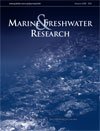Marine and Freshwater Research
Volume 63
Number 8 2012
Quantifying the ecological impacts of invasive fishes can guide management efforts and help predict the consequences of future incursions. We modelled the influence of Gambusia holbrooki on the occurrence, abundance and condition of wetland fish species in south-eastern Australia, and found that both G. holbrooki and local environmental factors shaped fish assemblage structure. The work highlights the success of G. holbrooki as an invader, while also illustrating the strong resistance of some native fishes to biotic and abiotic stressors.
Live coral cover is predicted to decrease with increasing levels of coral reef disturbance. We highlight the importance of coral structure for small parrotfishes which may enable them to resist strong water flow and to reduce predation. A future loss of coral cover appears to be particularly detrimental for small herbivorous fishes in high energy habitats, especially non-schooling species.
The diet of 0+ snapper, Chrysophrys auratus, is not well understood, especially for the species in Australia. We studied the diet of 0+ snapper within a major nursery region in southern Australia and identified spatial variation in snapper diet that was correlated to 0+ snapper abundance. These observations indicated that prey availability may be important as a driver of habitat selection.
Evidence suggests multiple subpopulations of Heterodontus portusjacksoni occur in its range. If true, then phenotypic variation may result in significantly different life-history parameters among regional groups. This study estimated rates of growth for H. portusjacksoni from South Australia, and made comparisons of the available life-history data among regional groups. While growth curves differed significantly among populations, considerable overlap among the some parameters prevented the delineation of definitive subpopulations.
Modelling the effects of ocean–climate variability on top predators will improve the comprehension of ecosystem dynamics. The generalised linear model described annual reproductive cycles of skipjack tuna and relationship between reproductive investment and subsurface seawater temperature. The results indicate that seasonal changes in oceanographic conditions affect reproductive biology of skipjacks through trophic linkage and biophysical coupling in the offshore ecosystems.
Recovery plans are being implemented for deepsea gulper sharks in Australia following overfishing. Three different genes were evaluated for checking fishery catch composition and one was found to be suitable for routine testing. At least two of the genes tested are likely to be useful for identifying gulper shark species that are very similar in appearance.
Understanding the possible effects of climate changes on key fishery species may allow managers and fishers to be better prepared for the future. A population model for barramundi (Lates calcarifer) that incorporated the effects of river discharge on recruitment and growth was used to explore the population response when discharge was altered under full licenced water abstraction and projected climate change, derived and downscaled from Global Climate model A1FI. Results indicated that managers of natural resources should be as concerned about the downstream effects of water abstraction as they are about long-term climate change. Consistently reduced river discharges into estuaries may undermine the inherent resilience of these systems.
A simulation modelling approach is developed to assist in the management of a valuable tropical prawn fishery. It tests a proposed management system that controls the catch of two species directly using a single total allowable catch, subject to existing effort controls. As such, it is the first management strategy evaluation that accounts for both input and output control simultaneously. The results indicate the new system keeps the fishery profitable, and prevents the stocks from being overexploited. However, there are times when the fishery is predicted to be unable to take the total allowable catch given the size of the fleet.
Accurate data on fish diets play a fundamental role in understanding trophic interactions and help explain habitat-use patterns and nutrient flow between systems. In the present study, the diet of a reef fish was characterised by visual identification and augmented with an alternative, non-visual-based method of diet analysis to generate identifications for macerated prey items that are challenging to identify. A DNA-based approach was capable of identifying prey items to the species level and, when combined with conventional visual analysis, helped reduce the number of unknown organisms recovered from stomach contents of French grunt.




